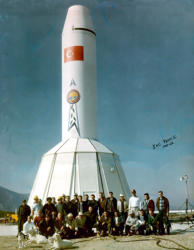
Jupiter SM-78 Weapon System
I&C Team 2, Çigli AB, Turkey 1961-1962 Chrysler Corporation Missile DivisionHISTORY - Page 24
Base, especially the Cape Canaveral complex. It appeared to ABMA that DOD would have to make a
thorough study of capabilities and requirements of this installation through 1960
31
.
DOD reacted quickly to the presentation and, on 15 December 1955, the development plan was tentatively
approved, that is, subject to some limitations and until better data were available. One of the
qualifications pertained to the guidance and control (G&C) development. The Army, in the plan, proposed
that a radio-inertial guidance scheme be developed as backup for the all-inertial guidance system, and
DOD felt that the system proposed for the Air Force might be considered as the alternate method.
Additionally, DOD believed that the solid propellant program, which was scheduled for eventual
submarine employment, should be coordinated with the Air Force. In fact, they went on to say there
should be a tri-service position on such development. Relative to the engine problem, OSD-BMC had
learned that the missile developers of the three services were studying the problem, and they had
requested a report on this matter from the Air Force by mid-January 1956. On Patrick facilities, a master
plan and test schedule for all programs was requested to be ready for submission in April 1956. Funds in
the amount of $50.8 million for FY 1956 and $111.1 million for FY 1957 were approved and, in addition,
funds for the tactical REDSTONE program could be used to expedite IRBM development. And lastly, OSD-
BMC desired that a monthly progress report be submitted covering component development, rocket engine
supply, flight test, and other items of importance
32
.
______________________________
31. Prop, subj: Army-Navy IRBM Tentative Dev Plan, op. cit.
32. Memo, Dep S/D to Chairman, JANBMC, 20 Dec 55, subj: IRBM #2 Pro, in ABMA Ref Book, subj: Important Props, Requests, & Directives, Tab F.









HISTORY - Page 24
Base, especially the Cape Canaveral complex. It
appeared to ABMA that DOD would have to make a
thorough study of capabilities and requirements of
this installation through 1960
31
.
DOD reacted quickly to the presentation and, on 15
December 1955, the development plan was
tentatively approved, that is, subject to some
limitations and until better data were available. One
of the qualifications pertained to the guidance and
control (G&C) development. The Army, in the plan,
proposed that a radio-inertial guidance scheme be
developed as backup for the all-inertial guidance
system, and DOD felt that the system proposed for
the Air Force might be considered as the alternate
method. Additionally, DOD believed that the solid
propellant program, which was scheduled for
eventual submarine employment, should be
coordinated with the Air Force. In fact, they went on
to say there should be a tri-service position on such
development. Relative to the engine problem, OSD-
BMC had learned that the missile developers of the
three services were studying the problem, and they
had requested a report on this matter from the Air
Force by mid-January 1956. On Patrick facilities, a
master plan and test schedule for all programs was
requested to be ready for submission in April 1956.
Funds in the amount of $50.8 million for FY 1956 and
$111.1 million for FY 1957 were approved and, in
addition, funds for the tactical REDSTONE program
could be used to expedite IRBM development. And
lastly, OSD-BMC desired that a monthly progress
report be submitted covering component
development, rocket engine supply, flight test, and
other items of importance
32
.
______________________________
31. Prop, subj: Army-Navy IRBM Tentative Dev Plan, op. cit.
32. Memo, Dep S/D to Chairman, JANBMC, 20 Dec 55, subj: IRBM #2 Pro, in ABMA Ref Book, subj: Important Props,
Requests, & Directives, Tab F.





















